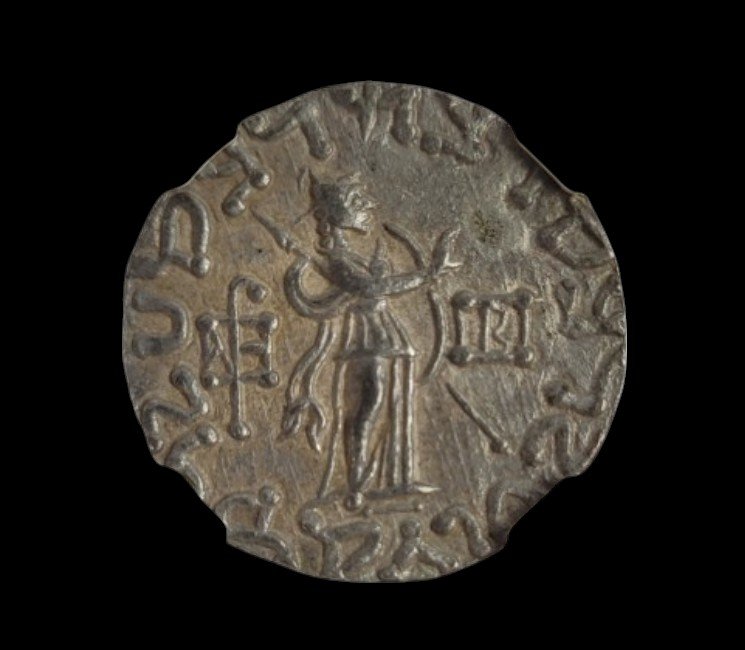 Image 1 of 4
Image 1 of 4

 Image 2 of 4
Image 2 of 4

 Image 3 of 4
Image 3 of 4

 Image 4 of 4
Image 4 of 4





Late Sasanian Empire Large Silver Drachmas (about 1,400-1,500 years ago)
These are substantial silver coins from the final flourishing period of the Sasanian Empire (in modern Iran), featuring distinctive royal portraits with elaborate crown designs that influenced early chess pieces.
Coin Description:
Front side: Portrait of a Sasanian king wearing an ornate crown unique to his reign
Back side: Typically shows a fire altar, a sacred symbol in Zoroastrianism
Technical Details:
Large silver drachma (a standard unit of currency)
Certified by NGC (Numismatic Guaranty Corporation)
Minted during the 6th-7th centuries CE
May feature one of three rulers: Khusru I, Hormizd IV, or Khusru II
Historical Significance: These coins represent the Second Golden Age of the Sasanian Empire, when the Persian civilization reached new heights of cultural and political influence. The Sasanian kings were renowned for their elaborate crowns, with each ruler having a distinctive design that became their royal symbol. Fascinatingly, some historians believe that the first chess pieces carved in the Sasanian Empire were modeled after these kings, with their ornate crowns based on those worn by Khusru and his successors—as seen on these remarkable silver coins. The Sasanian Empire was the last great Persian empire before the Islamic conquests, making these coins important witnesses to a vanishing ancient civilization.
These are substantial silver coins from the final flourishing period of the Sasanian Empire (in modern Iran), featuring distinctive royal portraits with elaborate crown designs that influenced early chess pieces.
Coin Description:
Front side: Portrait of a Sasanian king wearing an ornate crown unique to his reign
Back side: Typically shows a fire altar, a sacred symbol in Zoroastrianism
Technical Details:
Large silver drachma (a standard unit of currency)
Certified by NGC (Numismatic Guaranty Corporation)
Minted during the 6th-7th centuries CE
May feature one of three rulers: Khusru I, Hormizd IV, or Khusru II
Historical Significance: These coins represent the Second Golden Age of the Sasanian Empire, when the Persian civilization reached new heights of cultural and political influence. The Sasanian kings were renowned for their elaborate crowns, with each ruler having a distinctive design that became their royal symbol. Fascinatingly, some historians believe that the first chess pieces carved in the Sasanian Empire were modeled after these kings, with their ornate crowns based on those worn by Khusru and his successors—as seen on these remarkable silver coins. The Sasanian Empire was the last great Persian empire before the Islamic conquests, making these coins important witnesses to a vanishing ancient civilization.
These are substantial silver coins from the final flourishing period of the Sasanian Empire (in modern Iran), featuring distinctive royal portraits with elaborate crown designs that influenced early chess pieces.
Coin Description:
Front side: Portrait of a Sasanian king wearing an ornate crown unique to his reign
Back side: Typically shows a fire altar, a sacred symbol in Zoroastrianism
Technical Details:
Large silver drachma (a standard unit of currency)
Certified by NGC (Numismatic Guaranty Corporation)
Minted during the 6th-7th centuries CE
May feature one of three rulers: Khusru I, Hormizd IV, or Khusru II
Historical Significance: These coins represent the Second Golden Age of the Sasanian Empire, when the Persian civilization reached new heights of cultural and political influence. The Sasanian kings were renowned for their elaborate crowns, with each ruler having a distinctive design that became their royal symbol. Fascinatingly, some historians believe that the first chess pieces carved in the Sasanian Empire were modeled after these kings, with their ornate crowns based on those worn by Khusru and his successors—as seen on these remarkable silver coins. The Sasanian Empire was the last great Persian empire before the Islamic conquests, making these coins important witnesses to a vanishing ancient civilization.
The Sasanian Empire (/səˈsɑːniən, səˈseɪniən/), officially Ērānšahr (Middle Persian: 𐭠𐭩𐭥𐭠𐭭𐭱𐭲𐭥𐭩, lit. 'Empire of the Iranians'),[8][9][a] was an Iranian empire that was founded and ruled by the House of Sasan from 224 to 651. Enduring for just over four centuries, the length of the Sasanian dynasty's reign over ancient Iran was second only to the directly preceding Arsacid dynasty of Parthia.[11][12]
Founded by Ardashir I, whose rise coincided with the decline of Arsacid influence in the face of both internal and external strife, the House of Sasan was highly determined to restore the legacy of the Achaemenid Empire by expanding and consolidating the Iranian nation's dominions. Most notably, after defeating Artabanus IV of Parthia during the Battle of Hormozdgan in 224, it began competing far more zealously with the neighbouring Roman Empire than the Arsacids had, thus sparking a new phase of the Roman–Iranian Wars. This effort by Ardashir's dynasty ultimately re-established Iran as a major power of late antiquity.[13][14][15]
















